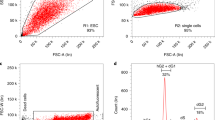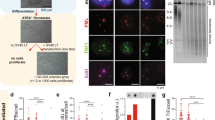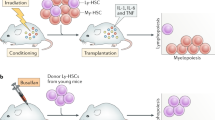Abstract
Cultured primary cells exhibit a finite proliferative lifespan, termed the Hayflick limit1. Cloning by nuclear transfer can reverse this cellular ageing process and can be accomplished with cultured cells nearing senescence2. Here we describe nuclear transfer experiments in which donor cell lines at different ages and with different proliferative capacities were used to clone foetuses and animals from which new primary cell lines were generated. The rederived lines had the same proliferative capacity and rate of telomere shortening as the donor cell lines, suggesting that these are innate, genetically determined, properties that are conserved by nuclear transfer.
This is a preview of subscription content, access via your institution
Access options
Subscribe to this journal
Receive 12 print issues and online access
$209.00 per year
only $17.42 per issue
Buy this article
- Purchase on Springer Link
- Instant access to full article PDF
Prices may be subject to local taxes which are calculated during checkout


Similar content being viewed by others
References
Hayflick, L. & Moorhead, P.S. The limited in vitro lifetime of human diploid cell strains. Exp. Cell Res. 25, 585–621 (1961).
Lanza, R.P. et al. Extension of cell life-span and telomere length in animals cloned from senescent somatic cells. Science 288, 665–669 (2000).
Smith, J.R. & Whitney, R.G. Intraclonal variation in proliferative potential of human diploid fibroblasts: stochastic mechanism for cellular aging. Science 207, 82–84 (1980).
Cristofalo, V.J., Allen, R.G., Pignolo, R.J., Martin, B.G. & Beck, J.C. Relationship between donor age and the replicative lifespan of human cells in culture: a reevaluation. Proc. Natl Acad. Sci. USA 95, 10614–10619 (1998).
Denning, C. et al. Deletion of the α(1,3)galactosyl transferase (GGTA1) gene and the prion protein (PrP) gene in sheep. Nat. Biotechnol. 19, 559–562 (2001).
Moyzis, R.K. et al. A highly conserved repetitive DNA sequence, (TTAGGG)n, present at the telomeres of human chromosomes. Proc. Natl Acad. Sci. USA 85, 6622–6626 (1988).
Olovnikov, A.M. A theory of marginotomy. The incomplete copying of template margin in enzymic synthesis of polynucleotides and biological significance of the phenomenon. J. Theor. Biol. 41, 181–190 (1973).
Hastie, N.D. et al. Telomere reduction in human colorectal carcinoma and with ageing. Nature 346, 866–868 (1990).
Harley, C.B., Futcher, A.B. & Greider, C.W. Telomeres shorten during ageing of human fibroblasts. Nature 345, 458–460 (1990).
Chin, L. et al. p53 deficiency rescues the adverse effects of telomere loss and cooperates with telomere dysfunction to accelerate carcinogenesis. Cell 97, 527–538 (1999).
Betts, D. et al. Reprogramming of telomerase activity and rebuilding of telomere length in cloned cattle. Proc. Natl Acad. Sci. USA 98, 1077–1082 (2001).
Zijlmans, J.M. et al. Telomeres in the mouse have large inter-chromosomal variations in the number of T2AG3 repeats. Proc. Natl Acad. Sci. USA 94, 7423–7428 (1997).
Itahana, K. et al. Control of the replicative life span of human fibroblasts by p16 and the polycomb protein Bmi-1. Mol. Cell. Biol. 23, 389–401 (2003).
Rheinwald, J.G. et al. A two-stage, p16(INK4A)- and p53-dependent keratinocyte senescence mechanism that limits replicative potential independent of telomere status. Mol. Cell. Biol. 22, 5157–5172 (2002).
Tian, X.C., Xu, J. & Yang, X. Normal telomere lengths found in cloned cattle. Nat. Genet. 26, 272–273 (2000).
Shiels, P.G. et al. Analysis of telomere lengths in cloned sheep. Nature 399, 316–317 (1999).
Miyashita, N., Shiga, K., Yonai, M., et al. Remarkable differences in telomere lengths among cloned cattle derived from different cell types. Biol. Reprod. 66, 1649–1655 (2002).
Wilmut, I., Schnieke, A.E., McWhir, J., Kind, A.J. & Campbell, K.H. Viable offspring derived from fetal and adult mammalian cells. Nature 385, 810–813 (1997).
Cui, W. et al. Stabilization of telomere length and karyotypic stability are directly correlated with the level of hTERT gene expression in primary fibroblasts. J. Biol. Chem. 277, 38531–38539 (2002).
Ouellette, M.M. et al. Subsenescent telomere lengths in fibroblasts immortalized by limiting amounts of telomerase. J. Biol. Chem. 275, 10072–10076 (2000).
Acknowledgements
The authors are grateful for technical support from the nuclear transfer and large animal teams at Roslin. This work was supported by the Biotechnology and Biological Sciences Research Council (BBSRC) and the Geron Corporation.
Author information
Authors and Affiliations
Corresponding author
Ethics declarations
Competing interests
This work was supported partly by the Geron Corporation, who provided financial support for the work including, in part, the employment cost of the some authors. Additionally, A.J.C. and I.W. are both consultants to and stockholders in the Geron Corporation.
Rights and permissions
About this article
Cite this article
Clark, A., Ferrier, P., Aslam, S. et al. Proliferative lifespan is conserved after nuclear transfer. Nat Cell Biol 5, 535–538 (2003). https://doi.org/10.1038/ncb992
Received:
Accepted:
Published:
Issue Date:
DOI: https://doi.org/10.1038/ncb992
This article is cited by
-
Cellular reprogramming and epigenetic rejuvenation
Clinical Epigenetics (2021)
-
Establishment and characterization of fetal fibroblast cell lines for generating human lysozyme transgenic goats by somatic cell nuclear transfer
Transgenic Research (2013)
-
Telomeres and Telomerase Biology in Vertebrates: Progress Towards a Non-Human Model for Replicative Senescence and Ageing
Biogerontology (2005)



